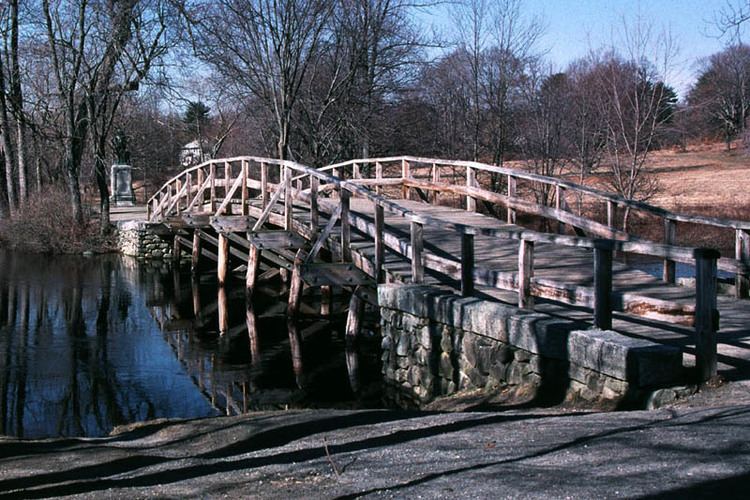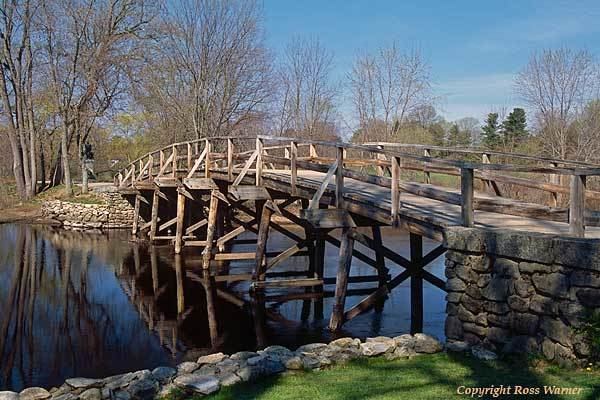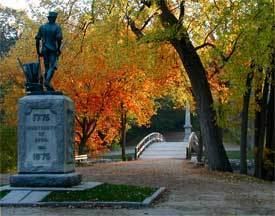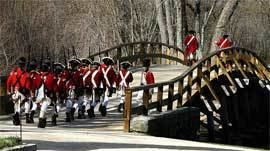Crosses Concord River Closed 1793 Body of water Concord River Rebuilt 2005 | Material Wood Opened 1956 Bridge type Footbridge Locale Concord | |
 | ||
Similar Minute Man National, The Old Manse, Lexington Battle Green, Sleepy Hollow Cemetery, Orchard House | ||
Old north bridge concord ma
The North Bridge, often colloquially called the Old North Bridge, is a historical site in the Battle of Concord, the first day of battle in the American War of Independence. The current wooden pedestrian bridge is a replica of the one that stood at the day of the battle. It and nearby sites are now part of the Minute Man National Historical Park of the National Park Service, an extremely popular tourist destination.
Contents
- Old north bridge concord ma
- Old north bridge historic boston and the american revolution
- Battle
- Bridge
- 1836 memorial
- 1875 memorial
- Graves of British soldiers
- 1975 Bicentennial Commemoration
- Nearby sites
- Other
- References

The current bridge is located in its original location off Monument Street in Concord, Massachusetts. It spans the Concord River 0.5 miles northeast from the start of the river at the confluence of the Assabet River and the Sudbury River at Egg Rock.

Old north bridge historic boston and the american revolution
Battle

In 1775, five companies of Minutemen and five of non-Minuteman militia occupied a hill near the bridge with groups of other men streaming in, totaling about 400 against the British light infantry companies from the 4th, 10th, and 43rd Regiments of Foot under Captain Walter Laurie, a force totaling about 90-95 men. The British retreated across the river and the two sides faced each other across the North Bridge.
A brief exchange of fire ensued which saw the first instance of Americans firing to deadly effect on British regulars, after which the British retreated. Ralph Waldo Emerson, positing that world history pivoted at that moment (an assertion that is disputed, as earlier events at Lexington Battle Green could be termed the true opening of the battle), called the first shot of this skirmish the "shot heard round the world" in his 1837 poem "Concord Hymn".
Bridge
The original North Bridge was dismantled in 1793 by the town of Concord because its use as a bridge had become impractical; a new bridge was erected a few hundred yards away. The bridge was rebuilt multiple times in 1875, 1889, and 1909. The current replica was built in 1956 and was based on drawings of the bridge built in the 1760s. The bridge was restored in 2005.
1836 memorial
In 1836, when there was no bridge at the site, the residents of Concord erected a memorial obelisk on the east side of the river, the side closest to the town center. Inscribed on the eastern (approach) side of the monument is: "HERE On the 19 of April, 1775, was made the first forcible resistance to British aggression[.] On the opposite Bank stood the American Militia[.] Here stood the Invading Army and on this spot the first of the Enemy fell in the War of that Revolution which gave Independence to these United States[.] In gratitude to GOD and In the love of Freedom this Monument was erected AD. 1836."
On Independence Day, July 4, 1837, the memorial was dedicated, an event for which Ralph Waldo Emerson wrote his "Concord Hymn". The first, and best known, of the four stanzas of this poem is:
By the rude bridge that arched the flood,
Their flag to April's breeze unfurled,
Here once the embattled farmers stood
And fired the shot heard round the world.
1875 memorial
The first stanza of "Concord Hymn" is inscribed at the base of the statue Minute Man by Daniel Chester French. The statue, which stands on a 7-foot-tall granite pedestal, was cast in the Ames Foundry in Chicopee, Massachusetts and was made from seven American Civil War cannons donated for the project by Congress. The statue, and the 1875 bridge, were dedicated on April 19, 1875 at a centennial recognition of the original battle of April 19, 1775.
Graves of British soldiers
American poet James Russell Lowell wrote in his poem "Lines" (1849) of the graves of two of the three British soldiers who died at the bridge:
Two graves are here: to mark the place,
At head and foot, an unhewn stone,
O'er which the herald lichens trace
The blazon of Oblivion.
But in 1910 residents of Concord placed a plaque to mark the graves using other lines from Lowell's poem:
Grave of British Soldiers
They came three thousand miles and died,
to keep the past upon its throne:
Unheard, beyond the ocean tide,
their English Mother made her moan.
April 19, 1775
The grave is at a rock wall near the bridge at its eastern end.
1975 Bicentennial Commemoration
On the 200th anniversary of the battle, President Gerald Ford traveled to Concord and gave a speech at the bridge as part of the United States Bicentennial celebrations.
Nearby sites
Among the natural areas near North Bridge are Egg Rock 0.5 miles southwest (upstream) at the confluence of the Assabet and Sudbury rivers, where they form the Concord River. Just 0.7 miles downstream from the bridge is a portion of the Great Meadows National Wildlife Refuge, an outstanding New England birdwatching location with a trail. Punkatasset Hill is northwest of the bridge and is where the colonial militias watched the British forces at the bridge. The hill is adjacent to Estabrook Woods, a wild tract of more than 1,200 acres (4.9 km2) of woodland, hills, ledge, and swamp that used to be visited by Henry David Thoreau.
A mansion was built over looking the bridge in 1911 by Stedman Buttrick, a great great grandson of Major John Buttrick who led the colonial forces to the bridge when they were fired upon by the British. In 1962 the National Park Service bought the mansion, its once extensive flower garden and surrounding land from the Buttrick family. It uses the building for a visitor center and administrative offices. Although the gardens created and cared for by Stedman Buttrick and his son Stedman have suffered since their purchase by the Park Service they were once grand enough to have been featured in a 15-page article in the May 1959 issue of National Geographic magazine.
The Old Manse, Emerson's ancestral home and later residence of writer Nathaniel Hawthorne, is immediately adjacent to the North Bridge.
On the east side of Monument Street, where the pedestrian crosswalk from the parking lot goes to the allée leading to the bridge, is chiseled in blocks a line from Emerson's address at the 1875 dedication of French's Minuteman statue alluding to how the local resistance to the King's troops had far-reaching effects: "The thunderbolt falls on an inch of ground, / but the light of it fills the horizon."
Other
The bridge was the inspiration for a bridge in Walt Disney World's Magic Kingdom, specifically the bridge leading from the hub in front of Cinderella Castle to the area celebrating American independence called Liberty Square.
